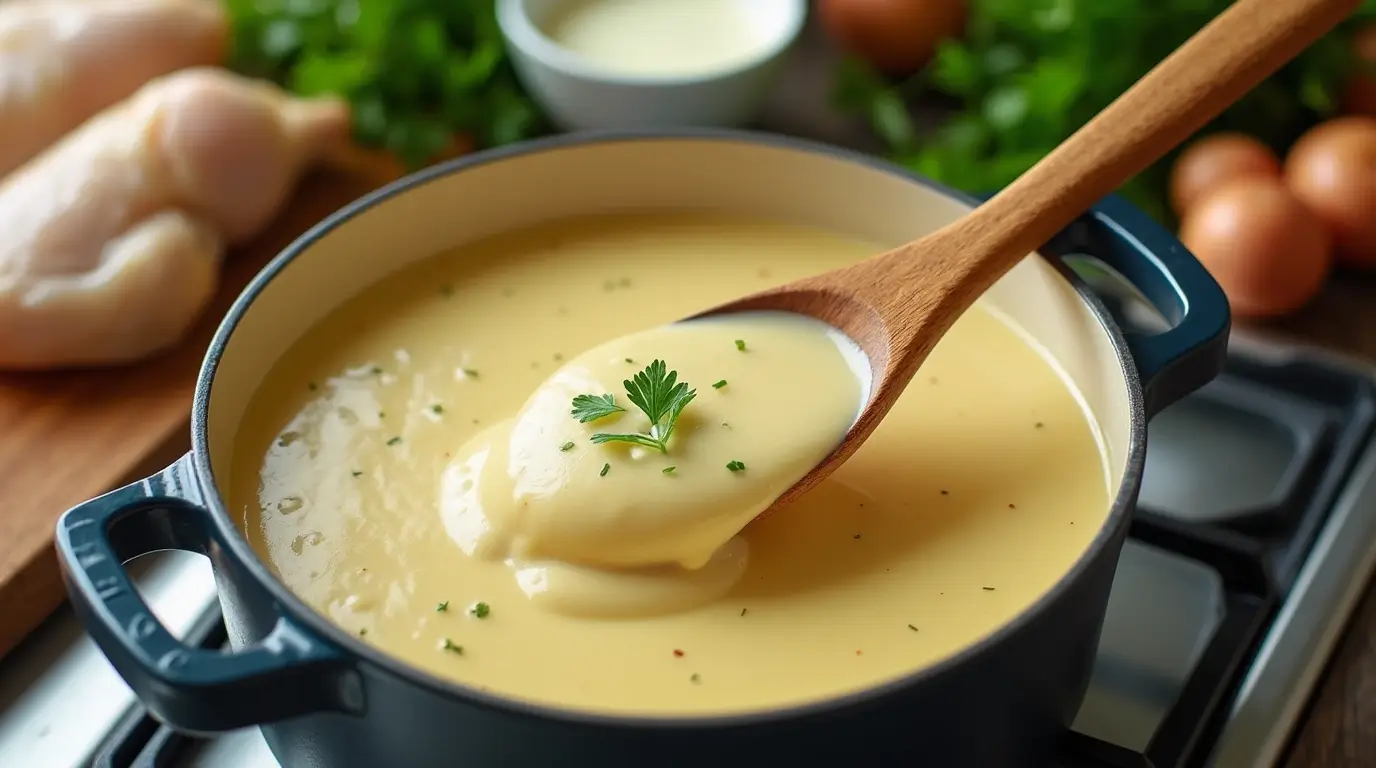There’s something undeniably comforting about a warm bowl of Cream of Chicken Soup—it’s rich, velvety, and packed with flavor. Over the years, this recipe has become one of my kitchen staples, not just as a stand-alone dish but as a secret weapon in so many other meals. A good cream of chicken soup can be the base for casseroles, pot pies, or even a quick pasta sauce when you’re short on time. When I first started cooking, I relied on the canned version, but once I realized how simple (and delicious!) it is to make from scratch, I never looked back. I’ll walk you through each step, and by the end, you’ll have a homemade soup that’s better than anything from a store. Plus, you can customize it to your taste, making it as rich, light, or herbaceous as you like. Let’s get started!
Table of Contents
What is Cream of Chicken Soup?
Cream of chicken soup is a rich, savory soup made by blending chicken stock with cream, flour, and seasonings to create a smooth, velvety texture. First introduced in the early 20th century as a canned convenience product, it quickly became a household favorite, thanks to its versatility and ease of use. Over time, it has evolved to include homemade variations and healthier options, catering to diverse tastes and dietary needs.
The rise of canned cream of chicken soup in the mid-1900s revolutionized home cooking, making it possible to prepare elaborate dishes in a fraction of the time. Today, it’s used not just as a standalone soup but as a base for casseroles, sauces, and more.
Nutritional Overview
Despite its reputation as a comfort food, cream of chicken soup can provide surprising nutritional benefits when consumed in moderation. It’s a good source of protein from the chicken and often contains essential vitamins like B6 and B12. However, it can be high in sodium and fat, especially in the canned versions, making it essential to check labels or consider homemade alternatives for healthier choices.
Key nutritional highlights:
- Protein: Supports muscle repair and immune health.
- Calcium and Vitamin D: Found in creamy varieties that use dairy.
- Iron: Essential for energy and overall vitality.
Understanding its composition allows you to balance the soup’s creamy indulgence with thoughtful ingredient choices. From its humble origins to its modern-day applications, cream of chicken soup remains a beloved cornerstone of comfort cooking.
Homemade Cream of Chicken Soup Recipes
Classic Homemade Cream of Chicken Soup Recipe
Making cream of chicken soup from scratch is simple and rewarding. Start by melting butter in a pot and whisking in flour to create a smooth roux. Gradually add chicken stock while stirring to avoid lumps. Once the mixture thickens, pour in heavy cream or milk for a velvety texture. Adding sautéed onions, garlic, and finely chopped chicken enhances both the flavor and heartiness of this homemade classic.
For those seeking more inspiration, check out this Deviled Egg Potato Salad for creative ideas that pair perfectly with cream-based soups.
Healthy Variations
Looking for lighter options? Substitute heavy cream with unsweetened almond milk or use a low-sodium chicken broth. Cornstarch or gluten-free flour can replace regular flour for those with dietary restrictions. These tweaks keep your soup nutritious without sacrificing its signature creaminess.
Experiment with pureed vegetables like cauliflower or carrots to add natural thickness and boost the nutrient profile. Whether you’re making it rich or light, cream of chicken soup can adapt to your preferences.
Top 5 Recipes Using Cream of Chicken Soup
One of the best things about homemade Cream of Chicken Soup is its versatility—it’s not just a soup; it’s a powerhouse ingredient that can elevate countless dishes. Whether you’re looking for a cozy casserole or a quick weeknight dinner, these are just a few of the countless option to incorporate Cream of Chicken Soup:

- Classic Chicken Pot Pie – a flaky, golden crust filled with creamy, savory goodness
- Cheesy Chicken and Rice Casserole – a family favorite that’s comforting and easy to make;
- Slow Cooker Chicken and Dumplings – the ultimate cold-weather meal with tender dumplings soaking up all the flavor
- Hashbrown Casserole – crispy, cheesy, and utterly addictive
- Creamy Chicken Enchiladas – a Tex-Mex favorite made extra luscious
Looking for more quick dishes? This recipe for Healthy Rotisserie Chicken Salad offers another protein-packed meal.
Benefits of Using Cream of Chicken Soup in Cooking
Flavor Enhancement
One of the most notable benefits of cream of chicken soup is its ability to enhance flavors. This creamy base elevates the taste of casseroles, soups, and sauces, creating a rich and savory profile. When paired with ingredients like chicken, mushrooms, or potatoes, the soup binds flavors together, turning simple recipes into gourmet-style dishes.
For more flavor-packed ideas, explore recipes like High-Protein Slow Cooker Meals to see how versatile creamy bases can be.
Convenience and Versatility
Using cream of chicken soup simplifies meal prep, saving time without compromising on taste. Its ready-to-use nature makes it a quick fix for soups, pasta dishes, and even pot pies. Moreover, the soup’s adaptability means it works in a variety of cuisines, from hearty American comfort food to light Mediterranean-inspired meals.
For more comforting ideas, explore 4 Ingredient Potato Soup to find unique ways to use soups for brunch or dinner.
Common Substitutes for Cream of Chicken Soup
Homemade Substitutes
Running out of cream of chicken soup shouldn’t derail your meal plans. A simple substitute can be made by whisking butter, flour, and chicken broth into a roux, then adding milk or cream for a smooth finish. This homemade alternative lets you control the sodium and fat content, ensuring a healthier dish.
For a dairy-free option, try blending unsweetened almond milk or coconut milk with cornstarch and vegetable stock. It’s a fantastic replacement for vegans or those avoiding dairy, without losing the creamy texture.
Commercial Substitutes
When in a pinch, canned alternatives like cream of mushroom or cream of celery soup can fill in. While they bring a different flavor, they still offer the same creamy consistency. Vegan-friendly canned soups are another option, often made with cashew or coconut bases for an equally rich texture.
FAQs About Cream of Chicken Soup
Can Cream of Chicken Soup Be Frozen?
Yes, cream of chicken soup can be frozen for later use. To preserve its creamy texture, store it in an airtight container or freezer bag, leaving some space for expansion. Homemade versions freeze particularly well, but canned soup can also be frozen once opened. Reheat it gently on the stove while stirring frequently to maintain the texture.
Is Cream of Chicken Soup Gluten-Free?
Most canned cream of chicken soup contains wheat flour, which is not gluten-free. However, you can find gluten-free options in stores or make your own by using cornstarch or gluten-free flour as a thickener. Pair it with gluten-free stock to ensure it’s safe for those with celiac disease or gluten sensitivities.
What Are Some Vegan Alternatives?
For vegan substitutes, opt for cashew cream or coconut milk as a base, paired with vegetable stock. Many brands now offer plant-based canned soups that mimic the creaminess and flavor of traditional options. These alternatives are perfect for incorporating into vegan casseroles or pasta dishes.
How Long Does It Last in the Fridge?
Opened canned cream of chicken soup or homemade versions can be refrigerated for 3–4 days. Always store it in an airtight container and check for signs of spoilage before using.
Creative Ways to Use Cream of Chicken Soup
As a Sauce Base
One of the most creative uses for cream of chicken soup is as a base for savory sauces. Simply mix it with a splash of milk, broth, or wine, and season with herbs to create a flavorful topping for meats or vegetables. For example, pour a creamy mushroom and chicken sauce over roasted chicken breasts or pan-fried pork chops for a quick, elegant meal.
Another idea is to use it as a pasta sauce. Combine cream of chicken soup with Parmesan cheese, garlic, and fresh parsley to coat your favorite pasta. It’s a quick way to make a rich, comforting dinner with minimal effort.
In Baked Dishes
Baked recipes truly shine when cream of chicken soup is involved. From casseroles to pot pies, its creamy consistency helps bind ingredients together while infusing every bite with savory flavor. Layer it with vegetables, shredded chicken, and puff pastry to create a hearty chicken pot pie.
For a new spin on comfort food, try incorporating it into stuffed bell peppers or baked zucchini boats. The soup keeps the filling moist while adding a luxurious texture.
In Breakfast Recipes
Surprisingly, cream of chicken soup can add a twist to breakfast dishes too. Use it in savory breakfast casseroles by combining it with eggs, hashbrowns, and cheese. It’s a unique and satisfying way to start the day, perfect for brunch gatherings or meal prep.
Tips for Storing and Reheating Cream of Chicken Soup
How to Store Cream of Chicken Soup
Proper storage ensures that your cream of chicken soup stays fresh and safe to eat. If using canned soup, always transfer any unused portions to an airtight container before refrigerating. Homemade soup should be cooled to room temperature before storage. Refrigerate for up to 3–4 days or freeze for up to three months.
For freezing, use freezer-safe containers and leave some space for the soup to expand. Label the containers with the date for easy tracking. Thaw frozen soup overnight in the refrigerator before reheating.
Reheating Tips
Reheating cream of chicken soup requires care to maintain its creamy texture. Avoid using high heat, which can cause the soup to separate. Instead, warm it gently on the stovetop over low heat, stirring frequently. Adding a splash of milk or broth can help restore its original consistency.
If reheating in the microwave, use a microwave-safe bowl and cover it loosely to prevent splatters. Heat in 30-second intervals, stirring in between to ensure even warming.
These tips help you make the most of your soup, whether it’s freshly made or repurposed from leftovers. Proper storage and reheating techniques keep it as delicious as the first time you made it!
Final Thoughts
Cream of chicken soup is a timeless kitchen staple that brings both convenience and flavor to countless dishes. From hearty casseroles and comforting pot pies to creative sauces and soups, its versatility knows no bounds.
As we’ve explored, there are endless ways to use this ingredient, along with simple storage tips and healthier substitutes to suit any dietary needs. By incorporating this comforting soup into your cooking, you can transform ordinary dishes into unforgettable favorites. So grab a can—or make your own—and let your culinary creativity shine!
Print
Cream of Chicken Soup
- Total Time: 40 min
- Yield: 4 servings 1x
Description
This Cream of Chicken Soup is not only comforting but also packed with rich flavors and wholesome ingredients.
Ingredients
For the Soup Base:

- 2 tablespoons unsalted butter
- 1 medium onion, finely chopped
- 2 celery stalks, diced
- 2 medium carrots, diced
- 2 garlic cloves, minced
For the Chicken:
- 2 cups cooked, shredded chicken (rotisserie chicken works great)
For the Broth and Cream:
- 4 cups chicken broth (low-sodium)
- 1 cup heavy cream
- 1/2 cup whole milk
- 1/4 cup all-purpose flour (or gluten-free flour for a GF option)
Seasonings:
- 1 teaspoon dried thyme
- 1/2 teaspoon dried rosemary
- 1/2 teaspoon paprika
- Salt and black pepper to taste
Optional Garnish:
- Fresh parsley, chopped
Instructions
1. Sauté the Vegetables
- In a large pot, melt the butter over medium heat.
- Add the chopped onion, celery, and carrots. Cook for 5–7 minutes until the vegetables are softened and aromatic.
- Stir in the minced garlic and cook for another 1–2 minutes, being careful not to burn it.
2. Add the Flour
- Sprinkle the flour over the vegetables and stir constantly for about 2 minutes to create a roux. This will help thicken the soup.
3. Add the Broth and Simmer
- Gradually whisk in the chicken broth to avoid lumps.
- Add the thyme, rosemary, and paprika. Stir well.
- Bring the soup to a gentle boil, then reduce the heat and let it simmer for 10–12 minutes to allow the flavors to meld.
4. Add the Chicken and Cream
- Stir in the shredded chicken and simmer for another 5 minutes to warm it through.
- Reduce the heat to low, then pour in the heavy cream and milk. Stir until the soup is creamy and heated, but do not let it boil to prevent curdling.
5. Adjust Seasonings and Serve
- Taste the soup and adjust the seasoning with salt and pepper as needed.
- Ladle the soup into bowls, garnish with chopped parsley, and serve hot.
Notes
- Thicker Soup: For a thicker consistency, blend a portion of the soup using an immersion blender or regular blender before adding the chicken.
- Make It Lighter: Substitute the heavy cream with half-and-half or evaporated milk for a lighter version.
- Add-Ins: For more texture, toss in cooked rice or noodles. You can also add mushrooms or peas for extra veggies.
- Storage: Store leftovers in an airtight container in the refrigerator for up to 3 days. Reheat gently on the stovetop or microwave, adding a splash of broth or milk if the soup thickens too much.
- Prep Time: 10 min
- Cook Time: 30 min
Nutrition
- Serving Size: 1 bowl (approximately 1.5 cups)
- Calories: 320
- Sugar: 4g
- Sodium: 540mg
- Fat: 20g
- Saturated Fat: 10g
- Unsaturated Fat: 8g
- Trans Fat: 0
- Carbohydrates: 15g
- Fiber: 2g
- Protein: 22g
- Cholesterol: 85mg

